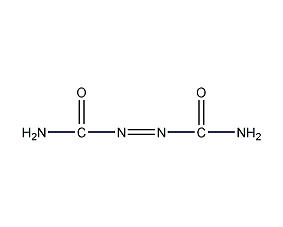
Structural formula
| Business number | 03H4 |
|---|---|
| Molecular formula | C2H4N4O2 |
| Molecular weight | 116.08 |
| label |
diazenedicarboxamide, Foaming agent ADC, Azodicarbonamide (0402 prohibited from air transport), Azobiscarboxamide, 2 triazepine amide, blowing agent ADC, Azodicarbonamide (0402 cut-off air), azobis formamide, foaming agent, treatment agent, food additives |
Numbering system
CAS number:123-77-3
MDL number:MFCD00007958
EINECS number:204-650-8
RTECS number:LQ1040000
BRN number:1704003
PubChem number:24847272
Physical property data
1. Appearance: white or light yellow powder
2. Relative density (20/4℃): 1.66
3. Melting point (℃): 225~2264. Decomposition temperature (℃): 1955. Solubility: soluble in alkali, insoluble in acid, alcohol, gasoline, benzene, pyridine and water, slightly soluble in ethylene glycol.
Toxicological data
1. Acute toxicity: Rat oral LD50: >6400mg/kg
Rat skin LD50: >500mg/kg
Rat peritoneal cavity LD50: 440mg/ kg
2. Other multiple dose toxicity: Rat oral TDLO: 42gm/kg/10D-C
Rat oral TDLO: 233gm/kg/4W-C
p>
Rat inhalation of TCLO: 207mg/m3/6H/2W-I
Rat inhalation of TCLO: 204mg/m3 /6H/13W-I
Rat transperitoneal TDLO: 252mg/kg/1W-I
Mouse inhaled TCLO: 217mg/m3 /6H/2W-I
Mouse inhaled TCLO: 204mg/m3/6H/13W-I
3. Mutagenicity: Salmonella mutation test system: 100ug /plate However, the raw material for production, hydrazine hydrate, is highly corrosive and highly toxic. Can corrode glass, rubber, leather and cork, etc. Vapors and liquids can corrode skin, eyes, nose, throat and mucous membranes.
Ecological data
None yet
Molecular structure data
1. Molar refractive index: 23.39
2. Molar volume (cm3/mol): 61.9
3. Isotonic specific volume (90.2K): 196.7
4. Surface tension (dyne/cm): 101.7
5. Polarizability (10-24cm3): 9.27
Compute chemical data
1. Reference value for hydrophobic parameter calculation (XlogP): -1
2. Number of hydrogen bond donors: 2
��, the average particle size is small, the cells are fine and uniform, the product feels good, and it is suitable for polymers such as PVC, PE, and EVA.
First-class product: widely used in ordinary PVC, PE, EVA and other foam products, and also used in rubber foam products.
Loose typeS: Compared with the first-class product, the product is loose and difficult to agglomerate, and has better dispersion. It is used for PVC foam slices, PVC, PE, PP, EVA and other foam products.
Micro typeV012: good dispersion, no grinding required, good oil absorption, high foaming rate, suitable for artificial leather, wallpaper, floor leather, sports soles, foam slippers, EVA, etc. Can be used as a substitute for imported products.
Micro typeV010: small average particle size, fine and uniform cells, high foaming ratio, good product feel, especially suitable for foam products that cannot contain silicon or carbonate, widely used in grades Higher plastic products, such as artificial leather, sports soles, wallpaper, foam slippers, etc., and polymers such as PVC, EVA, PE, PP, and PS, can be used in place of imported products.
Micro typeV008: The main performance and use are the same as V010. It can be used for foaming EVA and soft leather products, and can replace imported products.
Micro typeV006: The main performance and use are the same as V010. It is mainly used for secondary foaming of EVA, foaming of high-end artificial leather and other high-end products. It can replace imported products.
Low-temperature typeD180: has a low decomposition temperature and is suitable for low-temperature foaming of PVC, ABS, etc. It can extend the service life of foaming equipment and can replace imported products.
Low-temperature typeD170: has low decomposition temperature and is especially suitable for foaming processing of PP, PE, etc. that add effective joint agents. It has uniform cells and high foaming ratio, and can be used as a substitute for imported products.
Low temperature typeD160: mainly used for rubber plastics and can replace imported products.
A widely used organic high-efficiency foaming agent that can foam at normal pressure or under pressure. It has a large amount of gas and its decomposition products are non-toxic and non-toxic. Smelly and pollution-free. Suitable for polyethylene, polyvinyl chloride, polypropylene, polystyrene, ABS resin and other plastics as well as natural rubber, styrene-butadiene rubber, neoprene rubber, nitrile rubber, silicone rubber, etc. Pure white foam rubber and foam plastic products can be produced, as well as various thick or thin foam products. Organic acids and their salts, urea, borax, zinc oxide, ethanolamine, lead stearate, etc. have an activation effect on it and can significantly reduce the decomposition temperature. Food-grade azodicarbonamide can also be used as a wheat flour treatment agent and a rapid starter for baked goods. The maximum dosage is 45mg/kg wheat flour.


